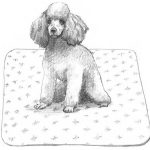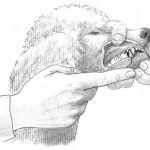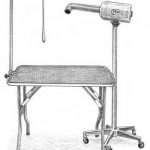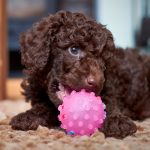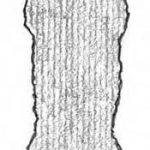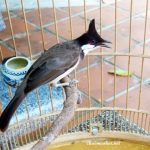Showing Off and Enjoying Your Poodle’s Talents

In This Chapter
Poodles are smart, active dogs. Any behavior you want to teach them, they can do, unlike kids, cats, and spouses. The only limitation may be size; you may be limited in what Toys and Miniatures can do physically. (Mentally, they can meet any challenge.) In this chapter, I explore some activities that you and your Poodle can do as a team. These activities provide great opportunities for exercise — for your Poodle’s brain and his body.
Remember
No matter what event you’re interested in, get a copy of the rules and regulations so you know what and what not to do. Order booklets about American Kennel Club (AKC) events at www.akc.org.
Tip
One more thing before you dive into the world of dog shows: You can successfully train your Poodle for competition by yourself. However, I suggest that you join a class. The environment adds distractions, and your Poodle will learn how to ignore other dogs in group exercises. See Chapter Housetraining Made Easy for more about taking your Poodle to training classes and teaching a variety of commands.
Passing the Canine Good Citizen Test
Preparing for the test
Remember
When your Poodle is ready to take the CGC test, you’ll discover that the AKC wants you to be a good citizen, too. Before the test, an administrator will ask you to sign a Responsible Dog Owners Pledge, which says you’ll take care of your dog’s health, needs, safety, exercise, training, and quality of life. You also agree to clean up after your dog in public places and to never let your dog infringe on the rights of others.
Taking the test
1. Accept a friendly stranger without breaking his position or going to the tester
2. Sit quietly and allow the tester to pet him
3. Allow the tester to run a brush over him and handle his ears and feet
4. Walk on a loose lead and make several turns and stops
5. Walk through a crowd without straining on the lead or jumping on people
6. Be put in a sit position and then in a down position; left and then returned to
7. Come when called from a distance of ten feet
8. Show minimal reaction to other dogs and be polite
9. Recover quickly when presented with distractions, such as a thrown pair of crutches
10. Not show signs of separation anxiety while you’re out of sight
Warning!
If your Poodle growls at, snaps at, bites, or attacks a person or another dog at any time during the CGC test, he’ll fail right then and there. But don’t worry; your Poodle can retake the test.
Looking Good: Conformation Shows
Remember
Conformation judging considers more than just your Poodle’s coat. Dog shows were originally staged to show off breeding stock, and that’s still the main objective of a show. Your Poodle must fit the breed standard and must be in condition. A flabby Poodle that doesn’t meet the standard won’t win, no matter how lovely his coat looks. Chapter Socializing Your Poodle has full details on breed standards.
How can you and your Poodle get ready for conformation shows?
Preparing your Poodle
Tip
You can show a Poodle in a puppy clip until he’s a year old; after that point, he must have either an English saddle clip or a continental clip (see Chapter Providing Your Poodle with a Nutritious Diet for more information on the types of clips). The puppy clip of the show ring is very different from the puppy clip that you may be familiar with on a pet Poodle:
– The show coat is much longer in a puppy clip.
– The mane and topknot are already being developed.
– The flpas feature longer hair.
– The feet, face, throat, and the base of the tail are shaved clean.
Preparing yourself
How does a conformation show work?
1. An official judges all the class males and calls the winners from each class to return to the ring, at which point she selects the Winners Dog.
This dog is the only dog to receive points toward a championship.
2. The judge repeats the process with the bitch classes, and the Winners Bitch receives the points.
3. The Winners Dog and the Winners Bitch return to the ring with all the champions, or specials, who’ve been entered.
4. In this class, also known as the Best of Breed class, the judge chooses the Best of Breed, Best of Opposite Sex (to the Best of Breed), and Best of Winners.
5. The dog chosen as the Best of Breed goes on to compete in group judging.
Seven groups compete in group judging. If you have a Toy Poodle, you show him in the Toy group. If you have a Miniature or a Standard, you show him in the Non-Sporting group.
6. The winners from each group advance to the Best in Show judging, where a judge chooses one dog as the Best in Show over all the other dogs entered.
Testing Skills: Rally Events
Tip
Unlike in formal obedience competitions, you can give multiple commands and talk to (and encourage) your Poodle. You may not touch your Poodle, but you can slap your leg, clap, and/or use hand signals to complete each exercise at the stations.
– Rally novice: The dog stays on lead for all the exercises, and you rally through 10 to 15 stations.
– Rally advanced: This level has between 12 and 17 stations, including at least one jump. Exercises are done off lead.
– Rally excellent: This level features between 15 and 20 stations and requires at least two jumps. Exercises are done off lead. At this level, the handler can give multiple commands but may not clap or pat her leg to encourage the dog.
Oh, Behave! Obedience Events
– Companion Dog (CD)
– Companion Dog Excellent (CDX)
– Utility Dog (UD)
– Utility Dog Excellent (UDX)
The humble beginnings of obedienceToday, obedience is a popular activity for ambitious dog owners. Breeders now recommend basic obedience training for dogs in pet homes. However, it wasn’t always this way. Two Poodle people are responsible for bringing obedience training to the attention of America’s dog owners. In 1931, Helene Whitehouse Walker imported three Standard Poodles from England, and she established Carillon Kennels. At the same time, she began reading about obedience tests that took place in England, and she became interested in bringing that practice to America. In 1933, Mrs. Walker organized the first obedience test in America, which she held in Mount Kisco, NY. In 1934, three more tests were held: one at Mount Kisco and two at all-breed shows. That same year, Mrs. Walker spent six weeks in England to discover more about obedience training. In December of 1935, Mrs. Walker submitted a pamphlet on obedience procedures to the AKC, and she requested recognition of the sport. The AKC approved of the new sport, and in April of 1936, the organization published “Regulations and Standards for Obedience Test Field Trials.” The first AKC-licensed tests were held at North Westchester on June 13, 1936 and Orange Kennel Club on June 14, 1936. With the AKC on board the obedience train, Mrs. Walker and her associate, Blanche Saunders (who wrote several books on obedience training), decided to spread the word about obedience across America. In September of 1937, they began a 10,000-mile “trailer trek.” They took three Standard Poodles on a trip to give demonstrations. They handed out pamphlets and lived in a 21-foot trailer, which they pulled with a Buick. They removed the backseat of the car, and the area became home to the three Poodles as they traveled! Fast forward to 1976. The AKC created a new title, OTCH (Obedience Trial Champion), to recognize dogs who reach the highest levels of obedience. In an age when Golden Retrievers and Border Collies seem to dominate the obedience ring, you can take solace in the fact that a Miniature Poodle, Ch. Andechez Zachary Zee, UD, was the first breed champion of any variety to earn the OTCH honor. |
Staying on Course: Agility Events
Remember
Agility takes strength and stamina from both you and your Poodle. Depending on the organization holding an agility event, you may not be able to compete in agility until your Poodle is at least 12 or 18 months old. The age requirement gives your dog a chance to grow up and develop the muscles he needs for agility. You can take the time before your Poodle hits the required age to begin training.
Surveying an agility course
– Jumps may be simple bar jumps, tires suspended from chains, or bars in varying height combinations.
– Contact obstacles each have an area that the dog must touch as he gets on and off the obstacle. The contact zone helps protect dogs from injury; you don’t want them leaping on or off an obstacle too far from the ground. The contact obstacles include the following:
- The A-frame is shaped like a giant “A,” and your dog must go up one side and down the other.
- The seesaw is just like the one you remember from your childhood. Your dog must get on at the end that touches the ground and walk across it until the other side drops to the ground.
- The dog walk is a narrow plank that leads from the ground to another plank that is parallel to the ground. Another plank leading back to the ground is at the other end.
Remember
A UKC agility course doesn’t have a dog walk, but it offers a sway bridge and a swing plank (see Chapter Socializing Your Poodle for more on this organization).
– At the pause table, your Poodle must sit or lie down, at the judge’s discretion, for five seconds.
– An open tunnel is a long tunnel (pretty simple!); it can be straight or have bends in it. A closed tunnel consists of a rigid section where the dog enters and a “closed” section that’s made of fabric. The dog must run through the collapsed fabric part to exit the tunnel.
– The weave poles are rows of poles through which your Poodle must navigate.
Looking at rules and levels
Tip
You can find other agility associations that offer events:
– Teacup Dogs Agility Association (www.dogagility.org) for dogs 17 inches and under
– Just for Fun (www.dogwoodagility.com/JustForFun.html) for dogs and owners who enjoy agility but not competition
On the Prowl: Hunt Tests
Equipping yourself and training
– Guns: For training, many people use blank or starter pistols. Otherwise, you’ll need a shotgun.
– Bumpers: A bumper is a plastic or canvas cylinder that you can throw either on land or in the water, where it will float. The weight and size of a bumper simulate what your Poodle will experience when he retrieves a bird on a hunt. Many plastic bumpers, or dummies, have knobby surfaces to encourage a soft mouth on the bird. Bumpers come in various sizes, from 2 to 4 inches in diameter and from 9 to 15 inches in length. You can find them at sporting and gun shops, in dog supply catalogs, and online. They range in price from $10 to $20 each.
– Birds: Eventually, you’ll need real birds to train your dog.
Tip
You should consider joining a retriever group for serious hunting training, because a club is more likely to have access to birds than individuals. And, even if you have access to birds, you know that each bird can cost $10 or more. To find a group, ask other dog people or your veterinarian, who may have clients to hunt. You also can search online for groups in your area.
Hunting at different levels
– A Junior dog is tested on four marks: two on land and two on water. A dog marks, or notices where a bird falls, before you can send him to retrieve it.
– For a Senior test, blind retrieves are added — both on land and on the water. A blind retrieve means that the dog can’t see the bird. He still marks it, but he can’t actually see the bird. On land, the bird may fall behind a bush; on water, the bird may be resting in reeds near the shore.
– At the Master level, your Poodle must deal with multiple marks and blind retrieves, as well as more distractions. Your dog also needs to honor another dog’s retrieves; in other words, he must remain in the heel position next to you (or his handler) while another dog works, if called upon to do so.
Earning qualifying scores
– To earn the Junior Hunter (JH) title, your Poodle must receive qualifying scores at five AKC-licensed or member-club hunting tests.
– To earn the Senior Hunter (SH) title, your dog needs to qualify at five AKC-licensed tests. If your dog holds a JH title, however, he needs only four qualifying tests.
– To earn the Master Hunter title, your dog must qualify at six tests. If he already has the SH title, he needs only five qualifying tests.
The Nose Knows: Tracking Tests
– Tracking Dog (TD)
– Tracking Dog Excellent (TDX)
– Variable Surface Tracking (VST)
Sharing the Love: Therapy Poodles
How a therapy dog helps
– Therapy dogs frequently visit healthcare facilities. A therapy dog can simply provide comfort, or he can take an active role in therapy sessions. For instance, a patient throwing a ball for a dog to retrieve can be a form of physical therapy.
– More schools bring in therapy dogs to be reading partners. Students like reading to dogs because dogs never criticize.
– Therapy dogs also can be of service during disasters. Not only can a therapy dog comfort the victims of a disaster but also rescue workers.
How to become certified (and other considerations)
– An ID tag for his collar signifying his status
– A card for your wallet for showing proof of certification.
– Information on visiting hospitals or other healthcare facilities
– Depending on the registering agency, you may have insurance coverage for you and your dog in case of an accident
Tip
Whether you want your Poodle to get certified or not, you need to make sure that he’s comfortable around the people he’s supposed to help. A dog who’s afraid of children won’t be of much use in a school. If you want to work in a healthcare facility, get your dog used to wheelchairs and walkers before you make your visits.
by Susan M.Ewing










